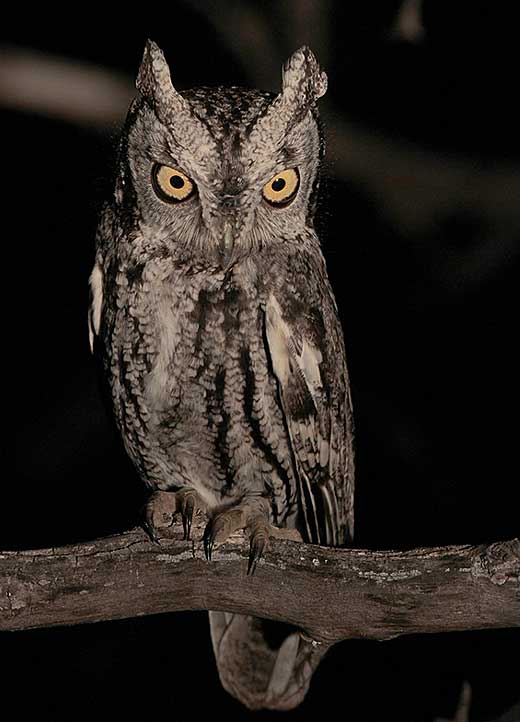The Western Screech-Owl (Megascops kennicottii) is a small owl with prominent ear tufts, mottled gray or gray-brown plumage, and darks bars and streaks on pale underparts.
This species mostly lives west of the Rocky Mountains although it also occurs throughout New Mexico, in central and western Texas, in southern eastern Colorado, and in parts of Kansas. It also lives in Mexico and ranges as far north as southern Alaska.
Western Screech-Owls are common, nocturnal birds of riparian zones, oak woodlands, and many other habitats.
On this page
Identification
The Western Screech-Owl is a small, chunky, grosbeak-sized owl with ear tufts. This species looks hefty but is only around 8.5 inches long, weighs just 5 ounces, and has a 20 inch wingspan.
Both sexes look the same, although females are a little bit bigger. They are mottled gray or gray and brown, have pale, “V”-shaped eyebrows, and a bit of a black border to their gray or pale brown faces.
This small owl also has some white spotting on the shoulders of its wings, has a dark gray or blackish beak, and small, feathered feet with sharp talons.
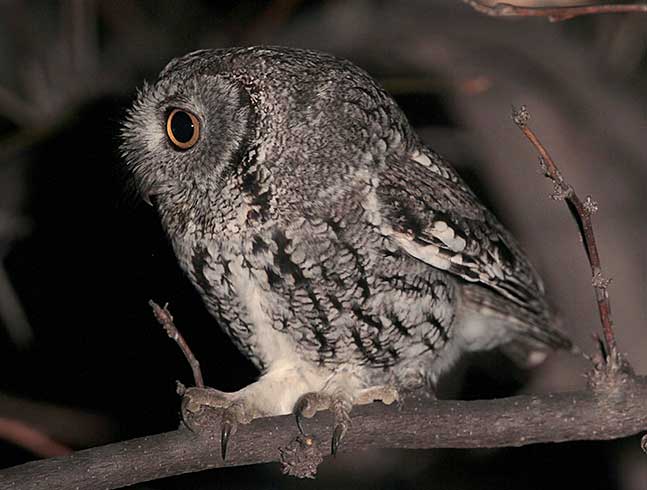
Its underparts are white with lots of fine dark barring and some blackish streaks. The black streaks are thicker on its upper chest. These plumage patterns help it blend in with the pattern of tree bark and hide it very well during the day.
In flight, the Western Screech-Owl flutters and glides on silent, long, rounded wings. However, since it is strictly nocturnal, during the day, this bird is rarely seen in flight.
It also has a short, broad tail with some dark banding.
Food
The Western Screech-Owl has a wide diet that varies according to where it lives. In general, though, this small owl feeds on a variety of insects and small animals. For example, owls that live near streams often catch crayfish and other small aquatic prey.
In areas with wet roadcuts and other places where earthworms are common, these invertebrates can make up a large part of the owl’s diet. They can also hunt worms at compost heaps where they can also go after various insects and mice.
Western Screech-Owls also prey on small mammals and small birds including House Sparrows, swallows, thrushes, or other small birds they manage to catch.
This nocturnal species does most of its hunting by perching on a branch just below the canopy of a tree, and then watching and waiting until prey reveals itself. When they hear or see a small animal, the owl quickly glides down to catch it with its talons.
Western Screech-Owls catch some of their prey by flying to vegetation and snatching the animals from the foliage.
They also sally for insects at night, catching bugs in the air with their talons.
Once in a while, they can also catch larger prey. However, killing animals like adult rabbits or ducks only happens when the animal in question is easy to catch because it is already injured or sick.
Nesting and Eggs
The Western Screech-Owl nests in tree cavities. It usually uses old nests of flickers and Pileated Woodpeckers and holes that form at the ends of broken tree limbs. This species also likes to nest in artificial nest boxes and can use crevices and holes in the side of a cliff.
It can use a cavity in any sort of tree but often uses Cottonwood, Big Leaf Maple, and cacti. Nesting holes are usually around 12 to 15 feet above the ground.
The male chooses the nest site and if the female likes it, she lays three to five white eggs on the floor of the nest cavity. The eggs are 1.4 inches long and weigh .61 ounces.
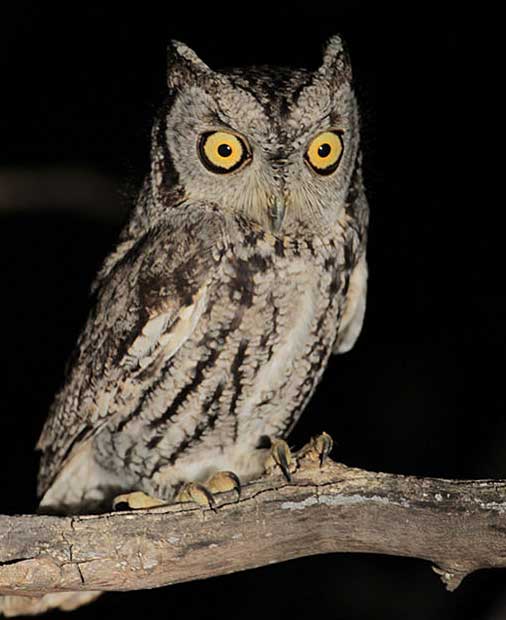
The female incubates the eggs for close to 30 days and is fed by the male during that time. After the eggs hatch, the male continues to feed his mate and the young owls while the female broods them (for three weeks).
At that point, the female also hunts to feed her young. A week later, they leave the nest and roost near it. For the next five weeks, the young owls start to do some hunting on their own but are still fed by their parents.
Vocalizations
Western Screech-Owls can make various barking and cackling calls but are best known for their commonly heard song. This vocalization is composed of short notes reminiscent of a “bouncing ball”, “whup…whup..whu,whu,whu,whu,waa”.
Current Situation
The Western Screech-Owl lives in many wooded and desert habitats from southern Alaska to central Texas and montane areas in central Mexico. In many parts of its range, it prefers to live along streams and next to lakes.
As long as large trees with cavities and some other natural habitats are present, it can also live in suburbs and even urban areas.
This species is listed as Least Concern in the IUCN Red List but, in western British Columbia, is a threatened species. It is also locally endangered in the southern interior region of that same province.
In Canada, Western Screech-Owls are threatened by habitat loss and predation by Barred Owls. In other parts of its range, this owl can be affected by removal of big, old trees, and other habitat changes.
One way to help this bird is by not using pesticides and installing nest boxes for it.
Facts
- Once in a while, Western Screech-Owls will take over the active nesting cavity of a woodpecker. They harass the flicker or other woodpecker species until it leaves and then take over the nest.
- Sadly, like some other owls, this species is susceptible to being hit by cars. Since owls fly, this may seem odd but they get hit by vehicles because they fly low to catch earthworms and other prey on or at the edges of roads.
- This species has a few different color morphs related to where they live. In the Pacific Northwest birds, as is common for animals that live in humid, dark forest, the owls are darker brown. In more arid regions, they tend to be paler gray.
- Despite their name, this and other screech-owl species don’t really have screeching songs. Although they can make odd barking and high-pitched wailing calls, the song of the Western Screech-Owl is more like the sound of a bouncing ball.
Similar Species
Small owls with ear tufts tend to have similar plumage and the Western Screech-Owl is no exception. This species looks pretty similar to some other owl species, including a few that live with or near it. Luckily, there are ways to recognize each of these species.
Eastern Screech-Owl
This species is very similar to the Western Screech-Owl but only comes into contact with it in Texas and maybe a couple of other areas at the eastern border of its range.
They can be separated by their song (the Eastern Screech makes “horse whinny” and long, tremulous calls), and the bill color (the Western’s beak is dark).
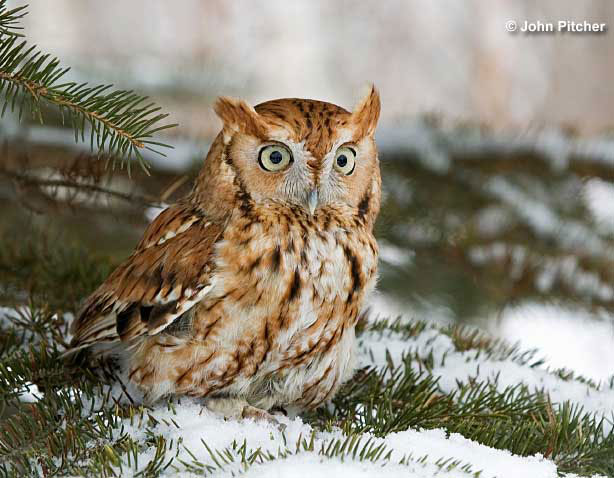
Eastern Screech-Owl
Flammulated Owl
This small owl species also has ear tufts, but they are shorter. It has dark eyes, and some reddish brown on its face and in its plumage.
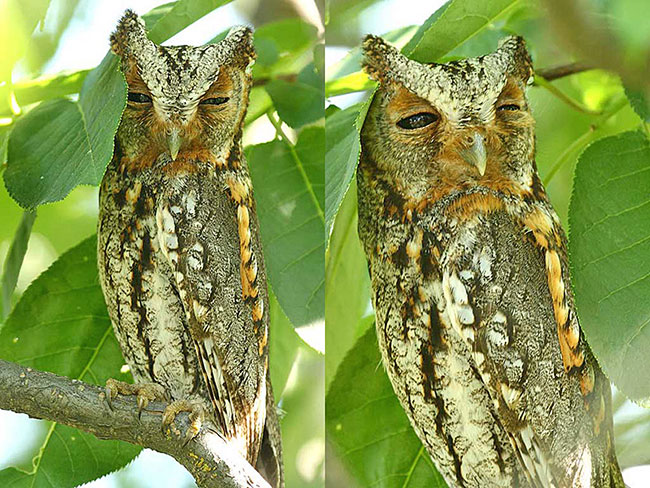
Flammulated Owl
Whiskered Screech-Owl
This very similar owl lives close to the Western Screech-Owl in southeastern Arizona but usually lives at higher elevations.
It also has thicker markings on its underparts, more orange-colored eyes, a paler beak, and small feet.
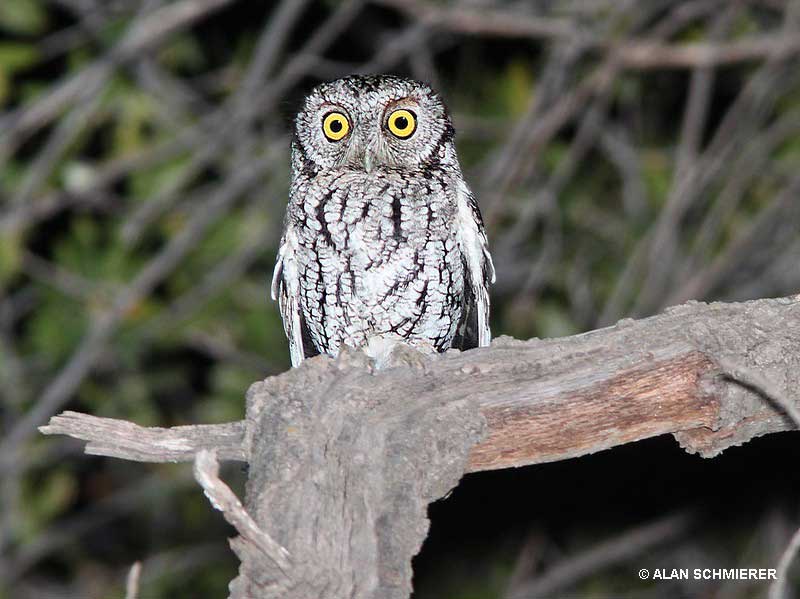
© ALAN SCHMIERER
Frequently Asked Questions
Are Western Screech-Owls friendly?
Western Screech-Owls are pretty friendly birds. They don’t bother people or pets and help control pests by eating insects, mice, and other small creatures.
Where do Western Screech-Owls live?
Western Screech-Owls live near streams and many other habitats in suburban and wilder areas in western North America. They range from southern Alaska south to central Texas and central Mexico. As long as big trees, big cacti, or nest boxes are present, these birds can also live in urban areas.
Do Western Screech-Owls come out during the day?
Western Screech-Owls are strictly nocturnal birds, only active at night. They hide during the day.
What is special about a Screech Owl?
A screech owl is special because it can hide very well during the day and live in many areas. As long as big trees are present, these small owls can thrive in city parks, gardens, and other urban situations.
Consider Next: Identifying Owls Family (All 23 Species in U.S)

